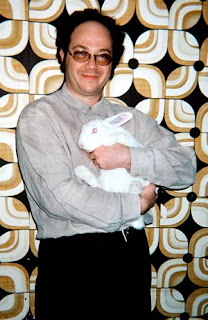Leonardo Art Science Evening Rendezvous
Two days ago I attended another LASER event at the CNSI building on campus. This time it focused on Nonlinear Perspectives and the Fourth State of Matter featuring talks by Walter Gekelman, Ana Jofre and Megan Lindeman. Each artist/scientist was introduced by Professor Vesna herself and presented their ideas and research using pictures and videos, and even an interactive model. Prior to the LASER event there was an art exhibition set up featuring very unique and interesting pieces.
(Me in front of paintings with aliens)
(A wire frame with light shining on it to display a face on the wall)
(What appears to be tiny construction paper arrows all moving in different directions)
The first speaker of the night was Ana Jofre, a physicist turned artist. She received a PhD in physics but has now transitioned her career towards the arts. She is currently a fellow at the Visual Analytics Lab at OCAD University. Jofre explained how she wants to contribute to culture, therefore she lives as a bridge builder between the sciences and arts. Her presentation was an intro to magnetism. She discussed electric fields, magnetic fields, electric currents and much more. She ended off with making an interactive model of a motor, using simply a copper wire and a battery. Jofre is a prime example of the collaboration of the two cultures, art and science.
(Motor made of a battery and copper wire)
The next speaker was Megan Lindeman, a visual artist who incorporates neurochemistry into her work. An example of this is one of her paintings called "Love and Its Case; Flowers and Oxycontin". Lindeman uses oxycontin and water paint to create a beautiful painting. The significance of this is that oxycontin is a drug that involves complex brain activity and trusting. Lindeman explained that she likes to have emotion and reason communicate in her art. As we learned in week 4, artists are often fascinated with the medical feild. Lindeman's incorporation of medicine and science into her art is a great collaboration of art and science.
<http://meganlindeman.com/?portfolio=oxytocin-collages>
The final speaker of the night was a UCLA plasma physicist named Walter Gekelman. Some people consider plasma the fourth state of matter. The work that Walter Gekelman does is create conditions for plasma and conduct experiments that are relevant to what happens on the suns surface. The plasma is heated at 300 million degrees, therefore humans can't be in the room with the machine or else their internal organs will begin to disintegrate. Robotic technologies operate it instead. This reminds me of Professor Vesna's lectures on Robotics in week three. New technologies are allowing for the development of robots to perform tasks that humans cannot do.
<http://dailybruin.com/images/39722_web.ns.1.24.plasmalab.picA.jpg>
I really enjoyed attending the LASER event. It is very interesting to listen to all of the different artists and science who have so much experience in their fields. I enjoyed hearing about their research and relating it back to what I have learned throughout the course of desma 9. I would definitely recommend that my classmates attend one of these events.
Citations
Jofre, Ana. "Biography". Ana Jofre. onewomancaravan.net, n.d. Web. 24 May. 2016.
Lindeman, Megan. "Love and Its Case; Flowers and Oxycontin". Megan Lindeman. Megan Lindeman, n.d. Web. 24 May. 2016.
Vesna, Victoria. "Medicine pt1." Youtube. Uconlineprogram. 21 Apr. 2012. Web. 21 May. 2016.
Vesna, Victoria. "Robotics pt.2." Youtube. Uconlineprogram. 15 Apr. 2012. Web. 24 May. 2016
Vesna, Victoria. "Robotics pt.2." Youtube. Uconlineprogram. 15 Apr. 2012. Web. 24 May. 2016
Vesna, Victoria. "TwoCultures part1." Youtube. Uconlineprogram, 30 Mar. 2012. Web. 24 May. 2016.


































